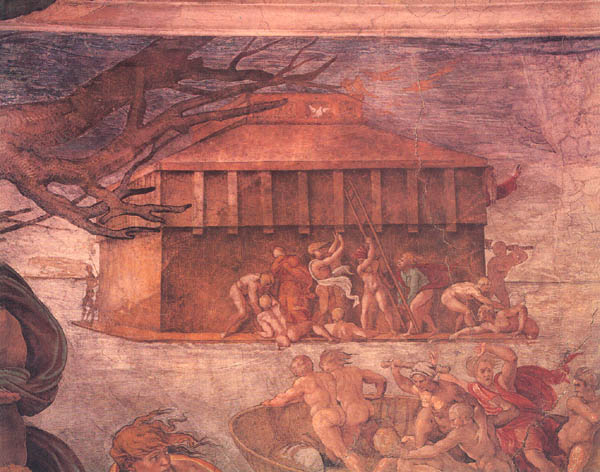Image Details

Art Resource
Swelling Waters sweep away the crowded ark as Noah’s household frantically scramble aboard the platform. Two of those who have already boarded—perhaps with the help of the ladder now rendered useless by the rising tide—lend a helping hand to those still in the water, but a partially obscured figure, right, raises an axe in a threatening gesture over a would-be refugee. In the upper level of the ark, Noah gestures with an upraised arm.
Panic overtakes the victims of the Flood confined to the small open boat in the foreground, and a fight breaks out as the occupants foresee their impending doom: They are not to be among the small remnant of people and animals God chose to survive.
This detail of a fresco by Michelangelo from the ceiling of the Sistine Chapel in the Vatican is one of the most dramatic representations of the Flood. Its portrayal of frantic struggle to board the ark contrasts with the biblical account describing the rather orderly boarding by Noah and his family and the animals.“And Noah and his sons and his wife and his sons’ wives with him went into the ark, to escape the waters of the Flood. Of clean animals, and of animals that are not clean, and of birds, and of everything that creeps on the ground, two and two, male and female, went into the ark with Noah, as God had commanded Noah” (Genesis 7:7–9). The only animal seen in Michelangelo’s fresco is the dove in the upper window of the ark.
The detail from the Flood story is part of the grandiose pictorial scheme for the Sistine Chapel conceived by Michelangelo and Pope Julius II to represent the world before Moses, beginning with the “Creation” and ending with the “Drunkenness of Noah.” The frescoes cover the ceiling, a flattened barrel vault more than 130 feet long. The project has been called the most ambitious pictorial undertaking in the entire Renaissance. Despite the magnitude of the task, Michelangelo completed the frescoes, with minimal assistance from apprentices, between 1508 and 1512. Michelangelo later claimed that he accepted his greatest commission unwillingly since sculpture, not painting, was his profession.
